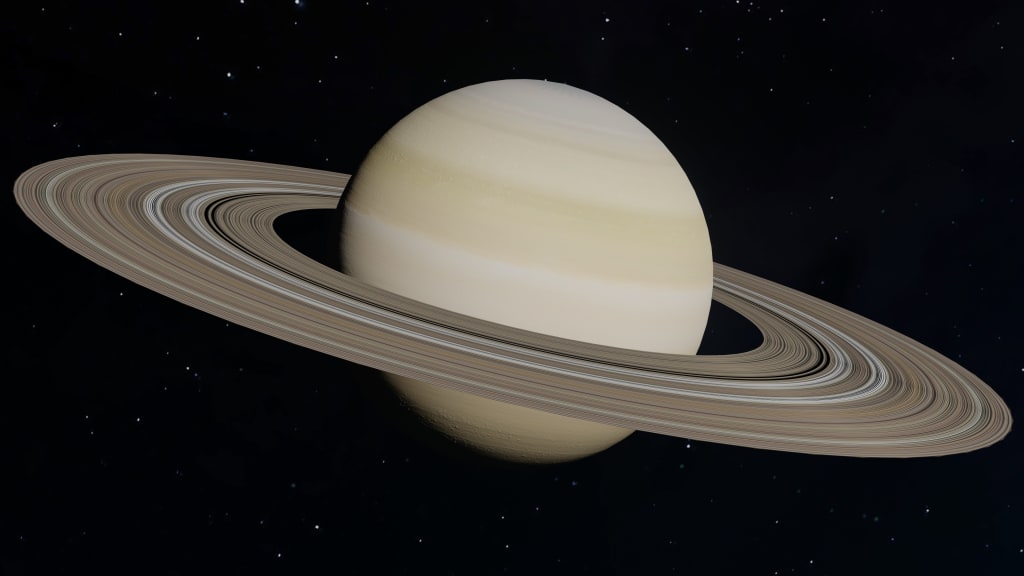
Saturn, the sixth planet from the Sun, is a gas giant with a diameter about nine times larger than Earth. It is best known for its stunning ring system, which is made up of countless individual rings made of ice particles and dust. Saturn is a fascinating and beautiful planet that has captivated astronomers and space enthusiasts for centuries. In this article, we will explore some of the most interesting facts about Saturn.
Saturn's Discovery and Characteristics
Saturn was first observed by Galileo Galilei in 1610, but it wasn't until 1655 that Dutch astronomer Christiaan Huygens discovered the planet's rings. Saturn is named after the Roman god of agriculture and wealth, and it is one of the four gas giants in our solar system, along with Jupiter, Uranus, and Neptune.
Saturn is approximately 886 million miles (1.4 billion kilometers) from the Sun, and it takes about 29.5 Earth years for Saturn to complete one orbit. The planet has a mass of 95 Earths and is composed mainly of hydrogen and helium gas. Its atmosphere contains trace amounts of other gases, including methane, ammonia, and water vapor.
Saturn's Rings
Saturn's rings are perhaps its most distinctive feature. The rings extend outwards from the planet's equator and are made up of billions of individual particles, ranging in size from tiny dust grains to large boulders. The rings are mostly composed of water ice, but they also contain traces of rock and other materials.
Saturn's rings are divided into several different regions, including the D, C, B, A, F, G, and E rings. The Cassini spacecraft, which orbited Saturn from 2004 to 2017, provided detailed information about the composition and structure of the rings.
Saturn's Moons
Saturn has at least 82 known moons, the largest of which is Titan. Titan is the only moon in our solar system with a dense atmosphere, and it is larger than the planet Mercury. Titan's atmosphere is primarily composed of nitrogen, and it also contains traces of methane and other gases. The Cassini spacecraft made several close flybys of Titan during its mission, providing scientists with detailed information about the moon's surface and atmosphere.
Another interesting moon of Saturn is Enceladus, which is believed to have a subsurface ocean of liquid water. This moon also has geysers that shoot water vapor and icy particles out into space, which have been studied in detail by the Cassini spacecraft.
Saturn's Magnetosphere
Saturn has a strong magnetic field, which creates a magnetosphere that extends far out into space. The magnetosphere is shaped like a teardrop, with its long tail pointing away from the Sun. The magnetosphere interacts with the solar wind, a stream of charged particles that flows out from the Sun, creating auroras near Saturn's poles.
Exploration of Saturn
Several spacecraft have been sent to explore Saturn and its moons, including Pioneer 11, Voyager 1 and 2, Cassini-Huygens, and Juno. The Cassini spacecraft was particularly successful in its mission, providing detailed information about Saturn's atmosphere, rings, and moons.
The Cassini spacecraft also made some remarkable discoveries, including the detection of a hexagonal-shaped storm at Saturn's north pole. The storm is a persistent feature that has been observed for decades, and its cause is still not fully understood.
Future Missions to Saturn
There are currently no active missions to Saturn, but several proposed missions are being considered by space agencies around the world. One proposed mission, known as the Saturn Probe, would send a spacecraft directly into the planet's atmosphere to study its composition and structure. Another proposed mission, known as the Dragonfly mission, is being planned by NASA to send a drone-like spacecraft to explore the surface of Saturn's largest moon, Titan.
The Saturn Probe mission would be a challenging and high-risk endeavor due to the extreme conditions present in Saturn's atmosphere. The spacecraft would need to withstand the intense heat and pressure of the planet's atmosphere, as well as the powerful winds and storms that are constantly present. However, the mission would provide invaluable insights into the composition and behavior of Saturn's atmosphere, which could help us better understand the processes that drive weather patterns and climate change on our own planet.
The Dragonfly mission, on the other hand, would focus on exploring the surface of Titan, which is considered to be one of the most Earth-like worlds in our solar system. The mission would involve sending a drone-like spacecraft to Titan's surface, where it would explore the moon's diverse landscape, including its lakes and seas of liquid hydrocarbons. The Dragonfly mission has the potential to uncover new insights into the origins and evolution of life in our solar system, as well as provide valuable information about the habitability of other worlds beyond Earth.
Other proposed missions to Saturn include the Enceladus Life Finder (ELF) mission, which would search for signs of life in the plumes of water vapor and organic material erupting from Saturn's moon Enceladus, and the Titan Saturn System Mission (TSSM), which would be a flagship mission designed to study both Titan and Saturn in detail over an extended period of time.
About the Creator
Hanaff Jr
Just Writer...






Comments
There are no comments for this story
Be the first to respond and start the conversation.